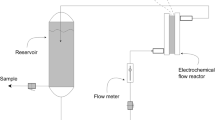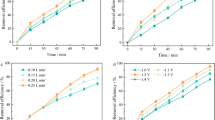Abstract
Since 2,4-dichlorophenol (2,4-DCP) as a priority pollutant is used in numerous industrial processes, its removal from the aqueous environment is of utmost importance and desire. Herein, the authors describe an electrochemical treatment process for efficient removal of 2,4-DCP from aqueous solutions using electro-Fenton (EF) process. Response surface methodology (RSM) was applied to optimize the operating parameters. Analysis of variance (ANOVA) confirmed the significance of the predicted model. The effect of independent variables on the removal of 2,4-DCP was investigated and the best removal efficiency of 98.28% achieved under the optimal experimental condition including initial pH of 3, H2O2 dosage of 80 μL, initial 2,4-DCP concentration of 3.25 mg L−1, current density of 3.32 mA cm−2, and inter-electrode distance of 5.04 cm. The predicted removal efficiency was in satisfactory agreement with the obtained experimental removal efficiency of 99.21%. According to the obtained polynomial model, H2O2 dosage revealed the most significant effect on degradation process. The kinetic investigation revealed that the first-order model with the correlation coefficient of 0.9907 and rate constant (Kapp) of 0.831 min−1 best fitted with the experimental results. Generation of the hydroxyl radicals throughout the EF process controlled the degradation process.








Similar content being viewed by others

References
Ahmadzadeh, S., & Dolatabadi, M. (2018a). Modeling and kinetics study of electrochemical peroxidation process for mineralization of bisphenol A; a new paradigm for groundwater treatment. Journal of Molecular Liquids, 254, 76–82.
Ahmadzadeh, S., & Dolatabadi, M. (2018b). Removal of acetaminophen from hospital wastewater using electro-Fenton process. [journal article]. Environmental Earth Sciences, 77(2), 53, https://doi.org/10.1007/s12665-017-7203-7.
Ahmadzadeh, S., Kassim, A., Rezayi, M., Abdollahi, Y., & Hossein, G. (2011a). A conductometric study of complexation reaction between meso-octamethylcalix [4] pyrrole with titanium cation in acetonitrile-ethanol binary mixtures. International Journal of Electrochemical Science, 6, 4749–4759.
Ahmadzadeh, S., Kassim, A., Rezayi, M., & Rounaghi, G. H. (2011b). Thermodynamic study of the complexation of p-isopropylcalix [6] arene with Cs+ cation in dimethylsulfoxide-acetonitrile binary media. Molecules, 16(9), 8130–8142.
Ahmadzadeh, S., Rezayi, M., Faghih-Mirzaei, E., Yoosefian, M., & Kassim, A. (2015a). Highly selective detection of titanium (III) in industrial waste water samples using meso-octamethylcalix[4]pyrrole-doped PVC membrane ion-selective electrode. Electrochimica Acta, 178, 580–589.
Ahmadzadeh, S., Rezayi, M., Karimi-Maleh, H., & Alias, Y. (2015b). Conductometric measurements of complexation study between 4-isopropylcalix[4]arene and Cr3+ cation in THF-DMSO binary solvents. Measurement, 70, 214–224.
Ahmadzadeh, S., Rezayi, M., Kassim, A., & Aghasi, M. (2015c). Cesium selective polymeric membrane sensor based on p-isopropylcalix[6]arene and its application in environmental samples. RSC Advances, 5(49), 39209–39217.
Ahmadzadeh, S., Asadipour, A., Pournamdari, M., Behnam, B., Rahimi, H. R., & Dolatabadi, M. (2017a). Removal of ciprofloxacin from hospital wastewater using electrocoagulation technique by aluminum electrode: optimization and modelling through response surface methodology. Process Safety and Environmental Protection, 109, 538–547. https://doi.org/10.1016/j.psep.2017.04.026.
Ahmadzadeh, S., Asadipour, A., Yoosefian, M., & Dolatabadi, M. (2017b). Improved electrocoagulation process using chitosan for efficient removal of cefazolin antibiotic from hospital wastewater through sweep flocculation and adsorption; kinetic and isotherm study. Desalination and Water Treatment, 92, 160–171. https://doi.org/10.5004/dwt.2017.21492.
Ahmadzadeh, S., Karimi, F., Atar, N., Sartori, E. R., Faghih-Mirzaei, E., & Afsharmanesh, E. (2017c). Synthesis of CdO nanoparticles using direct chemical precipitation method: fabrication of novel voltammetric sensor for square wave voltammetry determination of chlorpromazine in pharmaceutical samples. Inorganic and Nano-Metal Chemistry, 47(3), 347–353.
Babuponnusami, A., & Muthukumar, K. (2012). Advanced oxidation of phenol: a comparison between Fenton, electro-Fenton, sono-electro-Fenton and photo-electro-Fenton processes. Chemical Engineering Journal, 183, 1–9.
Dehghani, M. H., Dehghan, A., Alidadi, H., Dolatabadi, M., Mehrabpour, M., & Converti, A. (2017). Removal of methylene blue dye from aqueous solutions by a new chitosan/zeolite composite from shrimp waste: kinetic and equilibrium study. Korean Journal of Chemical Engineering, 1–9.
Doltabadi, M., Alidadi, H., Davoudi, M. (2016). Comparative study of cationic and anionic dye removal from aqueous solutions using sawdust-based adsorbent. Environmental Progress & Sustainable Energy.
Fouladgar, M., & Ahmadzadeh, S. (2016). Application of a nanostructured sensor based on NiO nanoparticles modified carbon paste electrode for determination of methyldopa in the presence of folic acid. Applied Surface Science, 379, 150–155.
Ghoneim, M. M., El-Desoky, H. S., & Zidan, N. M. (2011). Electro-Fenton oxidation of Sunset Yellow FCF azo-dye in aqueous solutions. Desalination, 274(1), 22–30.
Hasan, H. A., Abdullah, S. R. S., Kamarudin, S. K., & Kofli, N. T. (2011). Response surface methodology for optimization of simultaneous COD, NH 4+–N and Mn 2+ removal from drinking water by biological aerated filter. Desalination, 275(1), 50–61.
Huang, Y.-H., Huang, Y.-F., Chang, P.-S., & Chen, C.-Y. (2008). Comparative study of oxidation of dye-Reactive Black B by different advanced oxidation processes: Fenton, electro-Fenton and photo-Fenton. Journal of Hazardous Materials, 154(1), 655–662.
Huang, Z., Chen, G., Zeng, G., Guo, Z., He, K., Hu, L., Wu, J., Zhang, L., Zhu, Y., & Song, Z. (2017). Toxicity mechanisms and synergies of silver nanoparticles in 2,4-dichlorophenol degradation by Phanerochaete chrysosporium. Journal of Hazardous Materials, 321, 37–46.
Kamaraj, R., Davidson, D. J., Sozhan, G., & Vasudevan, S. (2014). Adsorption of 2,4-dichlorophenoxyacetic acid (2,4-D) from water by in situ generated metal hydroxides using sacrificial anodes. Journal of the Taiwan Institute of Chemical Engineers, 45(6), 2943–2949.
Kassim, A., Rezayi, M., Ahmadzadeh, S., Rounaghi, G., Mohajeri, M., Yusof, N. A., et al. (2011). A novel ion selective polymeric membrane sensor for determining thallium (I) with high selectivity. In IOP Conference Series: Materials Science and Engineering (Vol. 17, pp. 012010). IOP Publishing. https://doi.org/10.1088/1757-899X/17/1/012010.
Lante, A., Crapisi, A., Krastanov, A., & Spettoli, P. (2000). Biodegradation of phenols by laccase immobilised in a membrane reactor. Process Biochemistry, 36(1), 51–58.
Li, Y., Li, X., Li, Y., Qi, J., Bian, J., & Yuan, Y. (2009). Selective removal of 2,4-dichlorophenol from contaminated water using non-covalent imprinted microspheres. Environmental Pollution, 157(6), 1879–1885.
Moussavi, G., & Aqanaghad, M. (2015). Performance evaluation of electro-Fenton process for pretreatment and biodegradability improvement of a pesticide manufacturing plant effluent. Sustainable Environment Research, 25, 249–254.
Ortiz-Martínez, K., Reddy, P., Cabrera-Lafaurie, W. A., Román, F. R., & Hernández-Maldonado, A. J. (2016). Single and multi-component adsorptive removal of bisphenol a and 2,4-dichlorophenol from aqueous solutions with transition metal modified inorganic–organic pillared clay composites: effect of pH and presence of humic acid. Journal of Hazardous Materials, 312, 262–271.
Ouiriemmi, I., Karrab, A., Oturan, N., Pazos, M., Rozales, E., Gadri, A., Sanromán, M. Á., Ammar, S., & Oturan, M. A. (2017). Heterogeneous electro-Fenton using natural pyrite as solid catalyst for oxidative degradation of vanillic acid. Journal of Electroanalytical Chemistry, 797, 69–77.
Panizza, M., & Cerisola, G. (2009). Electro-Fenton degradation of synthetic dyes. Water Research, 43(2), 339–344.
Pardakhty, A., Ahmadzadeh, S., Avazpour, S., & Gupta, V. K. (2016). Highly sensitive and efficient voltammetric determination of ascorbic acid in food and pharmaceutical samples from aqueous solutions based on nanostructure carbon paste electrode as a sensor. Journal of Molecular Liquids, 216, 387–391.
Pouran, S. R., Aziz, A. A., & Daud, W. M. A. W. (2015). Review on the main advances in photo-Fenton oxidation system for recalcitrant wastewaters. Journal of Industrial and Engineering Chemistry, 21, 53–69.
Rezayi, M., Karazhian, R., Abdollahi, Y., Narimani, L., Sany, S. B. T., Ahmadzadeh, S., et al. (2014). Titanium (III) cation selective electrode based on synthesized tris(2pyridyl)methylamine ionophore and its application in water samples. Scientific Reports, 4, 1–8.
Rounaghi, G. H., Mohajeri, M., Ahmadzadeh, S., & Tarahomi, S. (2009). A thermodynamic study of interaction of Na+ cation with benzo-15-crown-5 in binary mixed non-aqueous solvents. Journal of Inclusion Phenomena and Macrocyclic Chemistry, 63(3), 365–372.
Sathishkumar, M., Binupriya, A., Kavitha, D., Selvakumar, R., Jayabalan, R., Choi, J., et al. (2009). Adsorption potential of maize cob carbon for 2, 4-dichlorophenol removal from aqueous solutions: equilibrium, kinetics and thermodynamics modeling. Chemical Engineering Journal, 147(2), 265–271.
Sharma, S., Kaur, J., Nagpal, A. K., & Kaur, I. (2016). Quantitative assessment of possible human health risk associated with consumption of arsenic contaminated groundwater and wheat grains from Ropar Wetand and its environs. Environmental Monitoring and Assessment, 188(9), 506.
Soltani, H., Pardakhty, A., & Ahmadzadeh, S. (2016). Determination of hydroquinone in food and pharmaceutical samples using a voltammetric based sensor employing NiO nanoparticle and ionic liquids. Journal of Molecular Liquids, 219, 63–67.
Vasudevan, S., & Oturan, M. A. (2014). Electrochemistry: as cause and cure in water pollution—an overview. Environmental Chemistry Letters, 12(1), 97–108. https://doi.org/10.1007/s10311-013-0434-2.
Villas-Boas, M. D., Olivera, F., & de Azevedo, J. P. S. (2017). Assessment of the water quality monitoring network of the Piabanha River experimental watersheds in Rio de Janeiro, Brazil, using autoassociative neural networks. Environmental Monitoring and Assessment, 189(9), 439.
Wada, S., Ichikawa, H., & Tastsumi, K. (1995). Removal of phenols and aromatic amines from wastewater by a combination treatment with tyrosinase and a coagulant. Biotechnology and Bioengineering, 45(4), 304–309.
Wang, S.-G., Liu, X.-W., Zhang, H.-Y., Gong, W.-X., Sun, X.-F., & Gao, B.-Y. (2007). Aerobic granulation for 2,4-dichlorophenol biodegradation in a sequencing batch reactor. Chemosphere, 69(5), 769–775.
Yoosefian, M., Ahmadzadeh, S., Aghasi, M., & Dolatabadi, M. (2017). Optimization of electrocoagulation process for efficient removal of ciprofloxacin antibiotic using iron electrode; kinetic and isotherm studies of adsorption. Journal of Molecular Liquids, 225, 544–553. https://doi.org/10.1016/j.molliq.2016.11.093.
Acknowledgements
The authors express their appreciation to Pharmaceutics Research Center, Institute of Neuropharmacology and Student Research Committee both affiliated to Kerman University of Medical Sciences, Kerman, Iran for supporting the current work.
Author information
Authors and Affiliations
Corresponding authors
Rights and permissions
About this article
Cite this article
Ahmadzadeh, S., Dolatabadi, M. In situ generation of hydroxyl radical for efficient degradation of 2,4-dichlorophenol from aqueous solutions. Environ Monit Assess 190, 340 (2018). https://doi.org/10.1007/s10661-018-6697-0
Received:
Accepted:
Published:
DOI: https://doi.org/10.1007/s10661-018-6697-0



